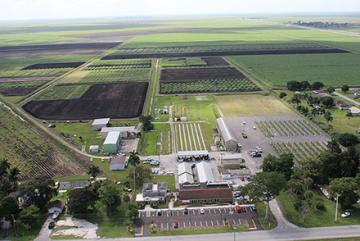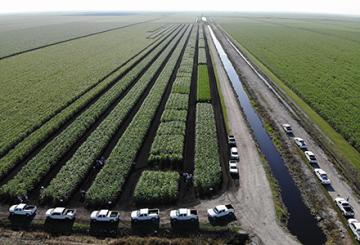A Century of Sugar

The USDA-ARS Sugarcane Field Station, in Canal Point, FL, celebrates its 100th anniversary this year. (Photo courtesy of Jim Shine, D4336-1)
On the eastern shore of Florida’s vast Lake Okeechobee sits the USDA-ARS Sugarcane Field Station, which celebrates its 100th anniversary this year. The location was chosen in 1920 because of the lake’s moderating effect on temperatures—keeping them above freezing in the winter. This mild climate is perfect for growing sugarcane, and it has helped the station achieve great success in breeding new and better cultivars and gain international recognition for its high-quality research.
The station, located in Canal Point, was originally established to supply “true seed” (seed from crosses of female and male parental plants) for USDA’s sugarcane breeding program in Houma, LA, and that mission guides the station to this day. But beginning in the 1960s, the station began developing cultivars that would grow well in Florida. Those cultivars bear the prefix “CP” for Canal Point. Since 1980, Florida’s sugar yield has increased from 4.51 tons per acre to 6.13 tons per acre, mainly the result of higher yielding CP varieties.
The success of this effort spurred expansion into Texas. Numerous public-private research partnerships were formed, and today, almost 100 percent of the Texas commercial acreage is planted with CP varieties. Of the sugar consumed in the United States today (11 million metric tons per year), 36 percent is from sugarcane grown in those three states, according to Duli Zhao, the station’s research leader.
Said Zhao, “Since the station was established, a total of 107 CP cultivars have been released for sugarcane growers and industry.” Just since 2015, 26 new CP varieties have been released with characteristics making them suited to different types of soils found in sugarcane-growing states. CP varieties are also widely planted in other countries. For example, Nicaragua has planted them on 98 percent of its commercial sugarcane acreage, according to the station’s data.

During its 100-year history, the Canal Point station released more than 100 sugarcane cultivars for growers and industry—a quarter of them just since 2015. (Everton Barreto, D4334-1)
Close collaboration with other countries is crucial, because sugarcane only thrives in tropical and subtropical climates. The station has Material Transfer Research Agreements with several countries and organizations so they can study Canal Point potential releases under a variety of environmental conditions. The station’s commitment to international partnerships is also evident in its staff. In the past 5 years, it has hosted eight international visiting scientists or graduate students from Brazil, China, Egypt, and Pakistan. Staff members routinely attend international meetings, visit breeding stations, and cooperate with foreign scientists, expanding the reach and impact of the station’s work.
A vital area of research is disease resistance. Sugarcane can be infected by several devastating diseases: orange rust, brown rust, smut, leaf scald, ratoon stunt, sugarcane yellow leaf virus, and mosaic. Canal Point scientists have developed ways to screen their plants for resistance or tolerance to these diseases. Orange rust, detected in Florida in 2007, appears to evolve rapidly, staying one step ahead of efforts to control it. Complicating matters is that if a plant has resistance to orange rust, it may still be susceptible to brown rust…and vice versa. Recent collaborative research has revealed genetic mechanisms behind brown rust resistance and found molecular markers for potential use in screening for orange rust resistance.
These many achievements have not gone unnoticed. “The Canal Point sugarcane research team received the ARS Technology Transfer Award in 2011 to recognize its efforts, accomplishments, impacts, and national and international contributions to sugarcane research and cultivar development,” said Zhao.
Because it’s grown on limited acreage, sugarcane is considered a “minor crop” in the United States. But sugar lovers everywhere know it’s much more than that. With 100 years of successes behind it, ARS’s sugarcane research at Canal Point will ensure plentiful supplies of sugar for years to come.—By Sue Kendall, ARS Office of Communications.

